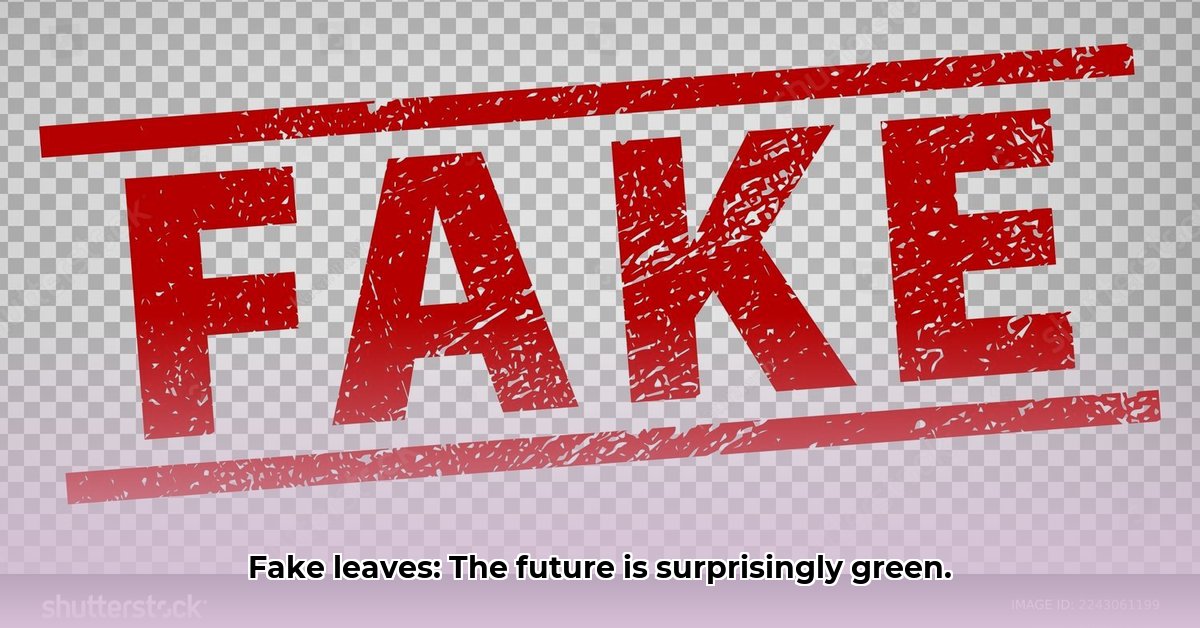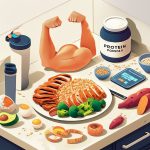Imagine a future where artificial leaves power clean energy and beautify our surroundings, impacting investors, researchers, and everyday consumers. The artificial leaf market is experiencing rapid growth, fueled by convenience, aesthetic appeal, and technological advancements. Understanding its dynamics is crucial for anyone interested in interior design, renewable energy, or sustainable practices. What are the driving trends and the challenges that lie ahead?
The Rise of Fake Foliage: Market Growth and Trends
The artificial foliage market is experiencing substantial growth, driven by the convenience and low maintenance compared to live plants. Real plants can be labor-intensive, requiring watering, sunlight, and pest management. Artificial leaves offer a hassle-free solution for vibrant greenery, suited for busy individuals or those lacking horticultural expertise. This convenience fuels the popularity of decorative artificial plants in homes, offices, and public spaces.
- Convenience: No watering, pruning, or special care.
- Busy lifestyles: Demand for low-maintenance decor increases.
- Consistent appearance: Vibrant color year-round is attractive.
- Durability: Long-lasting and resistant to environmental factors.
Artificial Leaf Manufacturing: The Blend of Art and Science
Creating realistic artificial foliage involves artistic design and scientific precision. Manufacturers use advanced techniques and materials to replicate the intricate details of natural leaves, including subtle veins, textures, and color variations. Innovation drives producing lifelike and affordable options. 3D printing, for instance, allows for creating complex and customized designs.
Artificial Leaf Materials: The Building Blocks of Realism
The material impacts appearance, feel, cost, and environmental footprint. Polyester remains a popular, affordable, and resilient option. Silk offers a luxurious touch, but at a higher price point. The industry is exploring innovative blends, polymers, and sustainable materials like recycled plastics and bio-based polymers, enhancing texture, color, and durability while minimizing environmental impact. Choosing the appropriate material balances aesthetics, budget, and sustainability.
Designs and Applications: Beyond Decoration
Artificial leaves have expanded beyond decorative arrangements, becoming essential elements in interior design, commercial spaces, event decorations, and theatrical productions. A “living wall” crafted from artificial leaves can transform an office or retail space, creating a visually appealing and biophilic design element. They are also used in landscaping, offering a low-maintenance alternative to real plants in challenging environments. Advancements in material science are expanding design possibilities, allowing for more complex and realistic creations.
Market Diversity: Options for Every Taste and Style
The fake leaf market is diverse, offering options for every taste, style, and budget, from inexpensive decorations to custom creations. Manufacturers specialize to target niche markets with unique designs and materials. Whether seeking a simple touch of green or an extravagant statement, there’s an artificial leaf product for every need.
Overcoming Challenges: Sustainability and Innovation
Environmental concerns associated with plastic production pose a challenge that companies address by incorporating recycled materials and exploring biodegradable alternatives. Developing truly eco-friendly options differentiates the market and appeals to conscious consumers. Additionally, some manufacturers are focusing on creating UV-resistant and fire-retardant artificial leaves, enhancing durability and safety.
The Future: Trends and Predictions
Key trends are poised to shape the future. Materials science advancements may lead to more realistic and durable artificial leaves. Customization options will likely become more prevalent, allowing consumers to tailor greenery to their specifications. “Smart” fake leaves incorporating sensors or other technological features may emerge, monitoring environmental conditions. Sustainability and responsible manufacturing practices will drive innovation.
Stakeholder Roles: A Collaborative Approach
| Stakeholder Group | Short-Term Actions | Long-Term Strategies |
|---|---|---|
| Manufacturers | Streamline production, cut costs | Invest in R&D of eco-friendly materials and innovative designs. |
| Retailers | Expand product lines, enhance customer service | Develop targeted marketing to specific customer groups. |
| Consumers | Choose eco-friendly options, prioritize quality | Consider longevity and versatility of products. |
| Environmental Advocates | Advocate for sustainable material use | Push for stronger regulations on plastic production, promote closed-loop recycling programs. |
| Government Regulators | Implement environmental standards. | Incentivize sustainable manufacturing, fund research into biodegradable materials. |
Continued innovation, sustainable practices, and a deep understanding of evolving consumer preferences are key to the fake leaf market’s continued success. Government regulations will play a significant role in promoting sustainable manufacturing and ensuring environmental responsibility.
Renewable Energy Applications: Artificial Leaf Technologies
Imagine artificial leaves generating fuel from sunlight and water, potentially operating at sea, capable of converting sunlight and water into clean fuels. Researchers have developed floating ‘artificial leaves’ for this purpose, requiring careful assessment of these technologies.[1]
Key Insights:
- The market is evolving, presenting growth opportunities for the future of renewable energy.
- Several factors influence the success and viability of different technologies and their environmental impact.
- Careful evaluation is crucial for both investors and researchers in the renewable energy sector.
Assessing Technologies for Renewable Energy: A Comprehensive Approach
The world of artificial leaf technology is developing with many innovative designs promising a greener future. Choosing the most promising technology involves examining characteristics. It’s like comparing vehicles, where you consider fuel efficiency, safety, and price. Comparing different artificial leaf technologies for renewable energy goes beyond a singular metric.
Capturing Solar Energy: Maximizing Conversion Efficiency
Efficiency determines how effectively a technology converts sunlight into usable energy. Higher efficiency equates to more fuel produced per unit area, essential for economic viability and minimizing land usage.
Scaling Up: From the Lab to Large Scale
Can a technology be scaled up from a controlled laboratory setting to meet the demands of large-scale production? Some designs might work well in a controlled environment, but fail to achieve consistent performance when scaled to mass production.
Weighing Costs: Examining Cost-Effectiveness and Material Requirements
The costs of materials, manufacturing, and maintenance impact a technology’s competitiveness. A highly efficient artificial leaf that’s prohibitively expensive has little practical use. Price per unit of energy produced is a crucial factor. Furthermore, the availability and sourcing of raw materials play a significant role in the economic viability and environmental impact.
Evaluating Environmental Impacts: A Holistic View
Producing artificial leaves requires resources. Evaluating the entire lifecycle—material sourcing, manufacturing, operation, and disposal—is necessary. Can these technologies be considered green throughout their lifespan? Considerations include the use of rare earth elements, the potential for leaching of materials into the environment, and the energy required for manufacturing.
Renewable Energy Artificial Leaf Comparison: A Step-by-Step Guide
Here’s a practical approach to comparing artificial leaf technologies:
- Define Your Needs: What is your target application (fuel production, water purification, carbon sequestration)? It is important to establish clear criteria.
- Gather Data: Collect information on efficiency, scalability, cost, and environmental impact for each technology, referencing peer-reviewed publications and reputable sources.
- Develop Metrics: Create a scoring system based on your defined needs. Assign weights to each criterion to reflect its importance.
- Compare Technologies: Analyze the collected data using your scoring system to reveal the strengths and weaknesses of each approach.
- Assess Risks: Identify potential technological, economic, and environmental concerns for each technology to facilitate informed decision-making.
Investing in Green: Securing a Sustainable Future
The market for artificial leaves shows promise. Assessing efficiency, scalability, cost-effectiveness, and environmental impact can build a future powered by sustainable energy. Further research in materials science and nanotechnology will contribute to more efficient and sustainable artificial leaves.
Applications in Vertical Farming: A Case Study
Key Insights:
- The combination of artificial leaves and vertical farming offers promising advancements in sustainable agriculture, although challenges remain in energy consumption and cost.
- Artificial leaves, capable of producing clean fuels, complement vertical farming’s potential for increased food production and reduced land use, presenting a sustainable alternative.
- Scalability, cost-effectiveness, and energy consumption represent hurdles for both technologies.
- Further research and development are crucial to address these challenges and unlock the full potential of these innovative approaches in the agricultural sector.
Unlocking Clean Energy: Artificial Photosynthesis
Imagine a world without seasonal or geographical constraints for plants. Artificial leaves offer a pathway to clean energy and carbon sequestration, and when coupled with vertical farming (growing crops in stacked layers), it could revolutionize agriculture.
Creating Controlled Environments: Vertical Farming’s Technological Edge
Vertical farming is about precision control, optimizing resource use, from water and nutrients to light and temperature through AI algorithms. Early disease detection is another advantage. Improvements in sensor technology and data analytics can enhance the efficiency of vertical farming.
Farming Meets Tech: Synergies and Opportunities
The combination of artificial leaves and vertical farming is compelling, with artificial leaves potentially offsetting the energy used for vertical farm lighting and climate control, leading to sustainable, localized food production.
Problems and Opportunities: Exploring the Challenges
There are challenges: scaling artificial leaf technology and making it cost-effective, addressing the energy needs of vertical farming (especially artificial lighting), requiring innovative solutions. We also need more research on the long-term environmental impacts, including waste management and material lifecycles.
The Future of Food: A Sustainable Vision
Despite challenges, the potential benefits are immense. Imagine urban farms providing fresh, locally-grown produce year-round, using AI to enhance the efficiency of vertical environments. “Artificial Leaves in Vertical Farming Applications: A Case Study” is a blueprint for a sustainable future, representing both opportunity and responsibility.
Research and Next Steps: A Roadmap
A multi-
- Bulking Lunch Recipes that Make Muscle Gain Delicious - November 12, 2025
- Simple Asian Meal Prep Recipes to Spice Up Your Week - November 11, 2025
- Simple Asian Meal Prep Ideas For Healthy And Flavorful Weekday Meals - November 10, 2025










